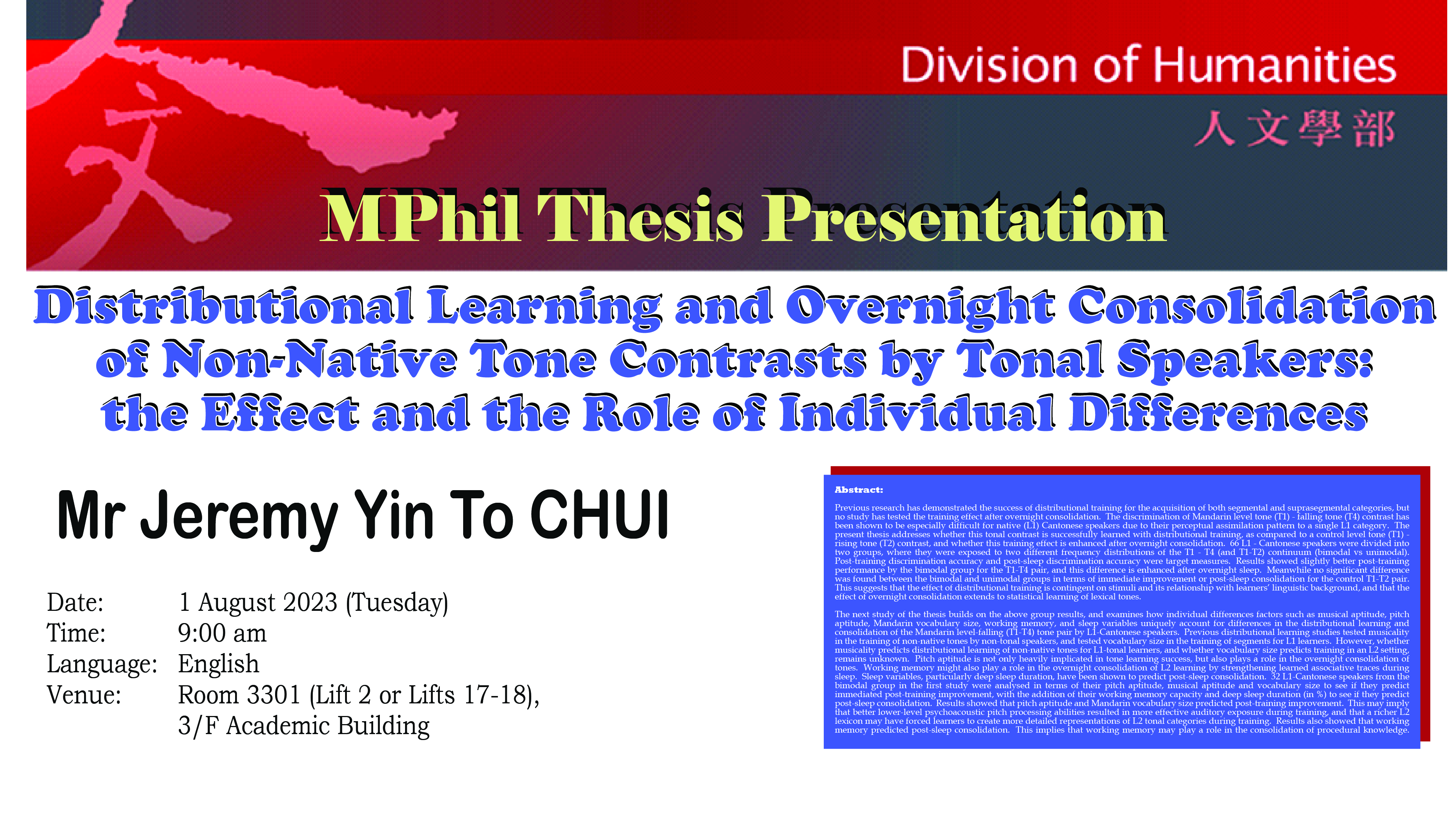Abstract:
Previous research has demonstrated the success of distributional training for the acquisition of both segmental and suprasegmental categories, but no study has tested the training effect after overnight consolidation. The discrimination of Mandarin level tone (T1) – falling tone (T4) contrast has been shown to be especially difficult for native (L1) Cantonese speakers due to their perceptual assimilation pattern to a single L1 category. The present thesis addresses whether this tonal contrast is successfully learned with distributional training, as compared to a control level tone (T1) – rising tone (T2) contrast, and whether this training effect is enhanced after overnight consolidation. 66 L1-Cantonese speakers were divided into two groups, where they were exposed to two different frequency distributions of the T1-T4 (and T1-T2) continuum (bimodal vs unimodal). Post-training discrimination accuracy and post-sleep discrimination accuracy were target measures. Results showed slightly better post-training performance by the bimodal group for the T1-T4 pair, and this difference is enhanced after overnight sleep. Meanwhile no significant difference was found between the bimodal and unimodal groups in terms of immediate improvement or post-sleep consolidation for the control T1-T2 pair. This suggests that the effect of distributional training is contingent on stimuli and its relationship with learners’ linguistic background, and that the effect of overnight consolidation extends to statistical learning of lexical tones.
The next study of the thesis builds on the above group results, and examines how individual differences factors such as musical aptitude, pitch aptitude, Mandarin vocabulary size, working memory, and sleep variables uniquely account for differences in the distributional learning and consolidation of the Mandarin level-falling (T1-T4) tone pair by L1-Cantonese speakers. Previous distributional learning studies tested musicality in the training of non-native tones by non-tonal speakers, and tested vocabulary size in the training of segments for L1 learners. However, whether musicality predicts distributional learning of non-native tones for L1-tonal learners, and whether vocabulary size predicts training in an L2 setting, remains unknown. Pitch aptitude is not only heavily implicated in tone learning success, but also plays a role in the overnight consolidation of tones. Working memory might also play a role in the overnight consolidation of L2 learning by strengthening learned associative traces during sleep. Sleep variables, particularly deep sleep duration, have been shown to predict post-sleep consolidation. 32 L1-Cantonese speakers from the bimodal group in the first study were analysed in terms of their pitch aptitude, musical aptitude and vocabulary size to see if they predict immediate post-training improvement, with the addition of their working memory capacity and deep sleep duration (in %) to see if they predict post-sleep consolidation. Results showed that pitch aptitude and Mandarin vocabulary size predicted post-training improvement. This may imply that better lower-level psychoacoustic pitch processing abilities resulted in more effective auditory exposure during training, and that a richer L2 lexicon may have forced learners to create more detailed representations of L2 tonal categories during training. Results also showed that working memory predicted post-sleep consolidation. This implies that working memory may play a role in the consolidation of procedural knowledge. Furthermore, it shows that any effects of musicality may have been overridden by L1-tonal experience in a statistical learning setting.
